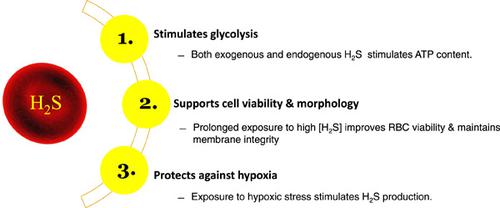当前位置:
X-MOL 学术
›
J. Cell. Physiol.
›
论文详情
Our official English website, www.x-mol.net, welcomes your feedback! (Note: you will need to create a separate account there.)
Effect of hydrogen sulfide on glycolysis-based energy production in mouse erythrocytes
Journal of Cellular Physiology ( IF 5.6 ) Pub Date : 2021-08-04 , DOI: 10.1002/jcp.30544 Eden T Wondimu 1, 2 , Quanxi Zhang 1, 3 , Zhuping Jin 1, 3 , Ming Fu 1, 4 , Roberta Torregrossa 5, 6 , Matthew Whiteman 5, 6 , Guangdong Yang 1, 7 , Lingyun Wu 1, 4, 8 , Rui Wang 9
Journal of Cellular Physiology ( IF 5.6 ) Pub Date : 2021-08-04 , DOI: 10.1002/jcp.30544 Eden T Wondimu 1, 2 , Quanxi Zhang 1, 3 , Zhuping Jin 1, 3 , Ming Fu 1, 4 , Roberta Torregrossa 5, 6 , Matthew Whiteman 5, 6 , Guangdong Yang 1, 7 , Lingyun Wu 1, 4, 8 , Rui Wang 9
Affiliation

|
Hydrogen sulfide (H2S) is a gasotransmitter that regulates both physiological and pathophysiological processes in mammalian cells. Recent studies have demonstrated that H2S promotes aerobic energy production in the mitochondria in response to hypoxia, but its effect on anaerobic energy production has yet to be established. Glycolysis is the anaerobic process by which ATP is produced through the metabolism of glucose. Mammalian red blood cells (RBCs) extrude mitochondria and nucleus during erythropoiesis. These cells would serve as a unique model to observe the effect of H2S on glycolysis-mediated energy production. The purpose of this study was to determine the effect of H2S on glycolysis-mediated energy production in mitochondria-free mouse RBCs. Western blot analysis showed that the only H2S-generating enzyme expressed in mouse RBCs is 3-mercaptopyruvate sulfurtransferase (MST). Supplement of the substrate for MST stimulated, but the inhibition of the same suppressed, the endogenous production of H2S. Both exogenously administered H2S salt and MST-derived endogenous H2S stimulated glycolysis-mediated ATP production. The effect of NaHS on ATP levels was not affected by oxygenation status. On the contrary, hypoxia increased intracellular H2S levels and MST activity in mouse RBCs. The mitochondria-targeted H2S donor, AP39, did not affect ATP levels of mouse RBCs. NaHS at low concentrations (3–100 μM) increased ATP levels and decreased cell viability after 3 days of incubation in vitro. Higher NaHS concentrations (300–1000 μM) lowered ATP levels, but prolonged cell viability. H2S may offer a cytoprotective effect in mammalian RBCs to maintain oxygen-independent energy production.
中文翻译:

硫化氢对小鼠红细胞糖酵解能量产生的影响
硫化氢 (H 2 S) 是一种气体递质,可调节哺乳动物细胞的生理和病理生理过程。最近的研究表明,H 2 S 促进线粒体响应缺氧产生有氧能量,但其对无氧能量产生的影响尚未确定。糖酵解是通过葡萄糖代谢产生ATP的厌氧过程。哺乳动物红细胞 (RBC) 在红细胞生成过程中会挤出线粒体和细胞核。这些细胞将作为一个独特的模型来观察 H 2 S 对糖酵解介导的能量产生的影响。本研究的目的是确定 H 2的影响S 对无线粒体小鼠红细胞中糖酵解介导的能量产生的影响。蛋白质印迹分析表明,在小鼠红细胞中表达的唯一 H 2 S 生成酶是 3-巯基丙酮酸硫转移酶 (MST)。补充 MST 底物刺激,但抑制同样抑制 H 2 S 的内源性产生。外源性施用的H 2 S盐和 MST 衍生的内源性 H 2 S 刺激糖酵解介导的 ATP 产生。NaHS 对 ATP 水平的影响不受氧合状态的影响。相反,缺氧增加了小鼠红细胞中的细胞内H 2 S 水平和MST 活性。线粒体靶向 H 2S 供体 AP39 不影响小鼠红细胞的 ATP 水平。在体外培养 3 天后,低浓度 (3–100 μM) 的 NaHS 增加了 ATP 水平并降低了细胞活力。较高的 NaHS 浓度 (300–1000 μM) 降低了 ATP 水平,但延长了细胞活力。H 2 S 可能在哺乳动物红细胞中提供细胞保护作用,以维持不依赖氧的能量产生。
更新日期:2021-08-04
中文翻译:

硫化氢对小鼠红细胞糖酵解能量产生的影响
硫化氢 (H 2 S) 是一种气体递质,可调节哺乳动物细胞的生理和病理生理过程。最近的研究表明,H 2 S 促进线粒体响应缺氧产生有氧能量,但其对无氧能量产生的影响尚未确定。糖酵解是通过葡萄糖代谢产生ATP的厌氧过程。哺乳动物红细胞 (RBC) 在红细胞生成过程中会挤出线粒体和细胞核。这些细胞将作为一个独特的模型来观察 H 2 S 对糖酵解介导的能量产生的影响。本研究的目的是确定 H 2的影响S 对无线粒体小鼠红细胞中糖酵解介导的能量产生的影响。蛋白质印迹分析表明,在小鼠红细胞中表达的唯一 H 2 S 生成酶是 3-巯基丙酮酸硫转移酶 (MST)。补充 MST 底物刺激,但抑制同样抑制 H 2 S 的内源性产生。外源性施用的H 2 S盐和 MST 衍生的内源性 H 2 S 刺激糖酵解介导的 ATP 产生。NaHS 对 ATP 水平的影响不受氧合状态的影响。相反,缺氧增加了小鼠红细胞中的细胞内H 2 S 水平和MST 活性。线粒体靶向 H 2S 供体 AP39 不影响小鼠红细胞的 ATP 水平。在体外培养 3 天后,低浓度 (3–100 μM) 的 NaHS 增加了 ATP 水平并降低了细胞活力。较高的 NaHS 浓度 (300–1000 μM) 降低了 ATP 水平,但延长了细胞活力。H 2 S 可能在哺乳动物红细胞中提供细胞保护作用,以维持不依赖氧的能量产生。



























 京公网安备 11010802027423号
京公网安备 11010802027423号